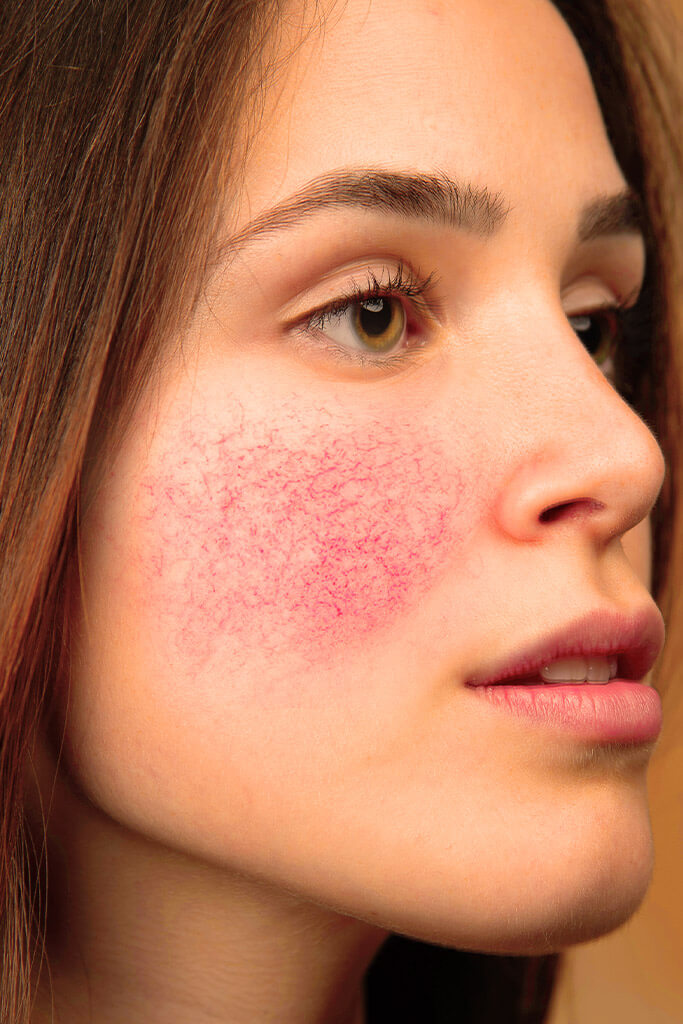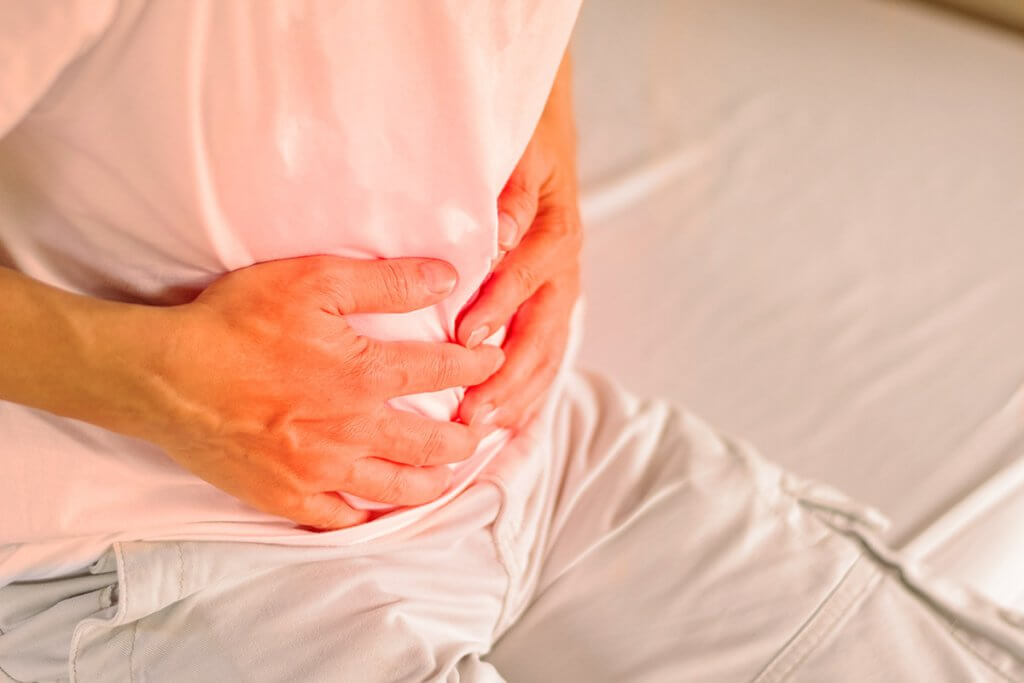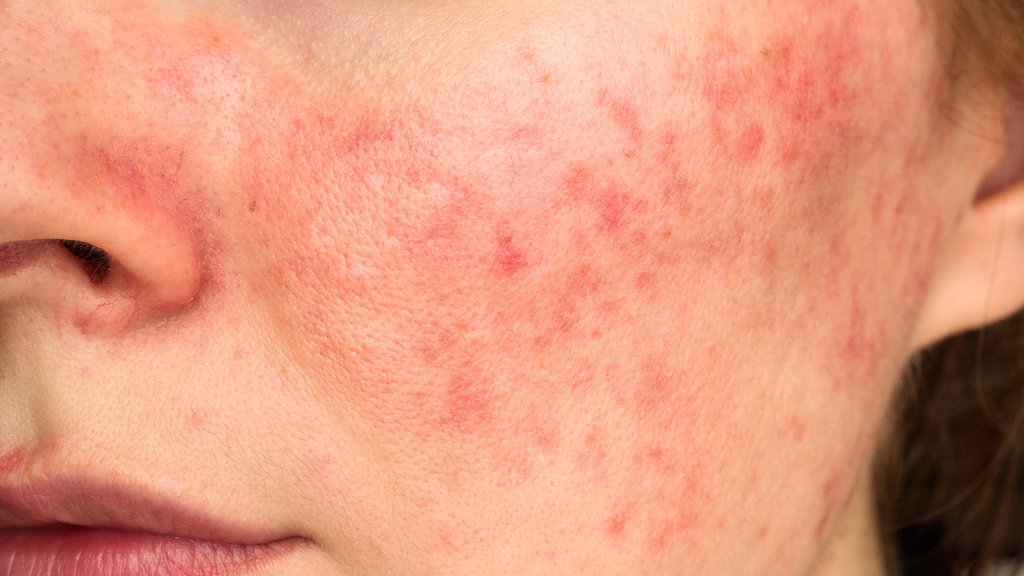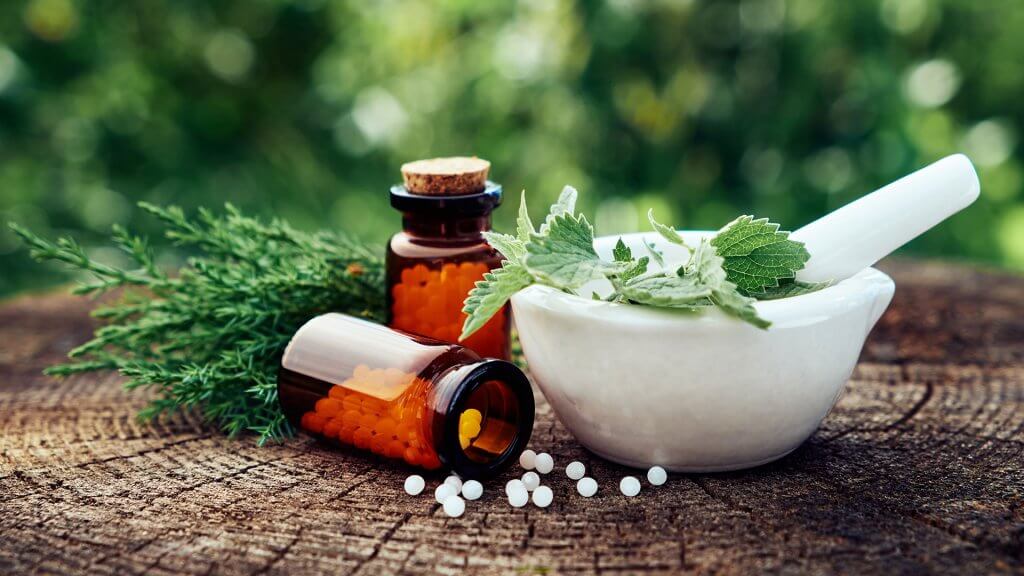Reduziere Rosacea
mit Sanubiom SkinCare Protect mit Phage Technology
Scientists have been investigating the possible cause of intestinal rosacea for some time. While the disease is still largely unexplored, there is increasing evidence that the gut is a possible trigger.
The inflammatory skin disease is usually accompanied by pustules and dilated veins. Those affected suffer from redness and itching on the face.
Rosacea patients often also struggle with various intestinal problems or even intestinal diseases.
A healthy gut acts as a natural protective shield against illness. If it is weakened, it can trigger rosacea and promote acute flare-ups.
Intestinal health plays an important role in alleviating symptoms.
On this page you can find out everything you need to know about the gut as a cause of rosacea and the influence of diet on the skin disease.

SKINCARE PROTECT
Probiotic skin protection SkinCare Protect with Phage Technology.
Your skin comes to rest.

Rosacea causes the fine veins in the skin to dilate, resulting in severe redness. Inflammation causes pustules and small nodules to appear, so that the face literally blossoms.
Although the symptoms are mainly visible on the face, the cause, as so often, lies within our organism. Numerous studies1 have shown that intestinal disorders and intestinal flora play a role in rosacea.
Patients are often affected by intestinal diseases such as irritable bowel syndrome, coeliac disease or an infection of the stomach with the Helicobacter pylori bacterium.
Chronic inflammatory bowel diseases such as Crohn’s disease or ulcerative colitis have also often been found to be associated with the skin disease.
Crohn’s disease is an inflammatory bowel disease. Its chronic course favors the development of acute flare-ups. Typical symptoms are frequent diarrhea and abdominal pain.
In Crohn’s disease, all layers of the intestinal wall are affected by the inflammation.
In many cases, the disease of the digestive system causes typical rosacea symptoms such as blotchy and scaly skin redness and swelling.


As a sufferer of ulcerative colitis, you should pay particular attention to changes in your skin. The disease attacks the intestinal mucosa and can thus promote the development of ulcers and bloody diarrhea.
During an acute flare-up, skin changes such as rosacea may also occur. Crohn’s disease and ulcerative colitis are among the most common chronic inflammatory bowel diseases.
Gluten intolerance not only affects the entire gastrointestinal tract, but also the skin in particular.
Coeliac disease is a genetic autoimmune disease. The consumption of gluten-containing foods leads to inflammatory processes in the intestinal mucosa, which is irritated and damaged in the long term.
The reactions are manifested by flatulence and abdominal pain, as well as skin rashes and reddening of the face.
Scientists have discovered that rosacea patients often have coeliac disease .


A bacterial infection of the gastric mucosa can also play a decisive role in rosacea. Triggers include Helicobacter pylori bacteria.
These cause an increased production of stomach acid, which in turn attacks the mucous membrane. The stomach attacks itself.
The human intestine consists of many sections, each of which has its own individual composition.
While the large intestine is known for its strong bacterial colonization, there are fewer microorganisms in the small intestine.
If the small intestine is incorrectly colonized, this can result in various symptoms such as a lack of nutrients, depression and also skin diseases such as rosacea.
Both too many bacteria and colonization with the wrong bacteria can damage the intestinal flora of the ileum.2
Rosacea sufferers are around 10 times more likely to suffer from SIBO than healthy people, which is why a close connection to the disease is suspected.

Even though the exact causes and correlations of rosacea are still largely unexplored, the term “gut-brain-skin axis” is used today.
This plays an important role in the connection between the skin and the gut microbiome.
Some bacteria in the digestive system are also said to cause symptoms outside the gastrointestinal tract.
The following bacteria are important for the rosacea cause intestine or gastrointestinal tract:
These bacteria can stimulate the immune system via signaling pathways in the brain and thus influence disease activity.
The rosacea cause intestine is intensified by various foods. There are 7 main groups of foods that are thought to trigger rosacea symptoms.
Find out more about: Diet for rosacea – foods you should avoid!

The skin disease rosacea is still largely unexplored. However, science is increasingly focusing on the gut as the cause of rosacea.
Intestinal problems or diseases of the gastrointestinal tract can therefore be the cause of redness on the face. A healthy and anti-inflammatory diet for rosacea helps to reduce the symptoms of the skin disease.
It is also advisable to avoid spicy or hot food. Sugar, fatty foods and alcohol should also be eliminated from the diet.
The special connection between the liver and the skin also plays a major role. Anthroposophic medicine has dealt with this special topic in a special way and has investigated and further developed Rudolf Steiner’s remedies and therapeutic indications.
In antroposophic medicine, the following skin diseases are considered typical liver dermatoses:
The liver is most frequently disturbed from the outside by the intake of harmful substances. The daily intake of pollutants such as food contaminated with pesticides, herbicides and heavy metals. But the preservatives, sweeteners, colorants and flavor enhancers in convenience foods are also metabolized in the liver, which tries to detoxify them. In addition, alcohol consumption puts the liver under pressure.
In the case of the skin disease rosacea, you can recognize the immediate effect that alcohol has on the liver and the immediate reddening of the face. Due to the existing liver weakness, negative emotions affect our mood and have a damaging effect on the organs. It is known from Chinese medicine that too much anger and rage damages the liver and causes the bile to overflow.

A healthy intestinal flora is of central importance for internal medicine. It not only ensures a strong immune system, but also contributes to radiantly clean skin. If the colonization of bacteria in the gut is disturbed, this can lead to skin diseases such as rosacea.
Anyone who suffers from rosacea is marked by the disease. Those affected struggle with redness on the face, papules and pustules.
Even if the disease is genetic and rosacea cannot be cured in principle, with the right treatment you can certainly alleviate the symptoms and regain your quality of life.
In the following article, we explain how our gut is linked to rosacea and how you can combat it with bacteriophages and a healthy diet.

Visible veins, papules and pustules: Rosacea is the most common cause of skin inflammation in Germany. But what is the connection between healthy intestinal flora and the noticeable redness on the face?
In contrast to the large intestine, our small intestine is actually hardly colonized by bacteria. In many rosacea patients, however, it has been shown that the small intestine is overgrown with germs.
While the microorganisms in the large intestine promote intestinal health, in the wrong place they can trigger chronic inflammatory bowel disease. Studies have shown that this in turn can have a negative effect on the skin disease rosacea1
There are around 100 trillion bacteria in the human gut.
There are numerous bacteria that attack our healthy gut flora and subsequently worsen the appearance of our skin.
Beneficial gut bacteria are now used to promote gut health and treat the typical rosacea nodules (papules).
We have compiled the most important information and tips for a healthy gut.
While the “good” microorganisms strengthen the balance of our intestines, others can attack the intestinal flora, weaken the digestive organ and thus cause illness. These include, among others:
To combat rosacea, you should first and foremost promote your intestinal health. A balanced , healthy rosacea diet not only provides you with sufficient prebiotic foods.
You also support your healthy intestinal flora and thus do a lot of good not only for your digestive tract, but especially for your skin.
Probiotics are known to promote intestinal health. However, very few people know about prebiotics. These are dietary fibers that cannot be processed by the body.
Prebiotic foods ensure that the desired bacteria already present in our gut feel comfortable, making it more difficult for pathogenic bacterial strains to spread in the gut.

Probiotic foods are ideal for rebuilding healthy intestinal flora in a natural way. These are living microorganisms, i.e. good bacteria.
They reach the intestines with the food and rebuild our immune system there by displacing unwanted germs. The probiotics Bifidobacterium lactis and Lactobacillus paracasei have an anti-inflammatory effect and are particularly helpful for rosacea and sensitive skin.
In addition to sufficient fruit and vegetables, you should also consume enough healthy, i.e. unsaturated fatty acids. The short-chain fatty acids serve as food for the good probiotic intestinal bacteria and thus ensure vitality and well-being.
It is also advisable to drink lukewarm water. Sugary or alcoholic drinks, on the other hand, should be avoided as they tend not to contain probiotics and instead promote the growth of dangerous bacteria.
In addition to probiotics and a healthy diet, bacteriophages can also be used in the treatment of rosacea.
Phage Technology uses bacteriophages to specifically combat bad bacteria. This prevents them from attacking the healthy intestinal flora, triggering chronic inflammatory bowel diseases and subsequently promoting rosacea.
Sanubiom SkinCare Protect specifically combats malignant bacteria such as Staphylococcus aureus and thus rebalances the microbiome.
At Sanubiom, we believe that everyone has a right to beautiful skin. Make use of your right with Sanubiom Skin Care Protect!
Author: Katharina Hillinger
“Our skin nourishes, detoxifies and protects our body. But in order for it to fulfill its functions, our skin flora must be in balance. Healthy skin is characterized by a diverse ecosystem of microbes that form a kind of protective shield.”
Share post: